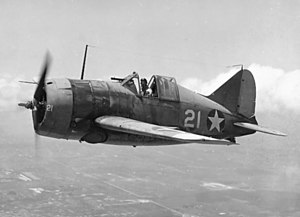| F2A Buffalo | |
|---|---|
 | |
| General information | |
| Type | Fighter aircraft |
| National origin | United States |
| Manufacturer | Brewster Aeronautical Corporation |
| Primary users | United States Navy |
| Number built | 509 |
| History | |
| Manufactured | 1938–1941 |
| Introduction date | April 1939 |
| First flight | 2 December 1937 |
| Retired | 1948 (Finland) |
| Developed into | VL Humu |
The Brewster F2A Buffalo[1] is an American fighter aircraft which saw service early in World War II. Designed and built by the Brewster Aeronautical Corporation, it was one of the first U.S. monoplanes with an arrestor hook and other modifications for aircraft carriers. The Buffalo won a competition against the Grumman F4F Wildcat in 1939 to become the U.S. Navy's first monoplane fighter aircraft. Although superior to the Grumman F3F biplane it replaced, and the early F4Fs,[2] the Buffalo was largely obsolete when the United States entered the war, being unstable and overweight, especially when compared to the Japanese Mitsubishi A6M Zero.[3][better source needed]
Several nations, including Finland, Belgium, Britain and the Netherlands, ordered the Buffalo. The Finns were the most successful with their Buffalos, flying them in combat against early Soviet fighters with excellent results.[4] During the Continuation War of 1941–1944, the B-239s (de-navalized F2A-1s) operated by the Finnish Air Force proved capable of engaging and destroying most types of Soviet fighter aircraft operating against Finland at that time, and claimed in the first phase of that conflict 32 Soviet aircraft shot down for every B-239 lost,[5] producing 36 Buffalo "aces".[6]
In December 1941, Buffalos operated by both British Commonwealth (B-339E) and Dutch (B-339C/D) air forces in South East Asia suffered severe losses in combat against the Japanese Navy's A6M Zero and the Japanese Army's Nakajima Ki-43 "Oscar". The British attempted to lighten their Buffalos by removing ammunition and fuel and installing lighter guns to improve performance, but it made little difference.[7] After the first few engagements, the Dutch halved the fuel and ammunition load in the wings, which allowed their Buffalos (and their Hurricanes) to stay with the Oscars in turns.[8]
The Buffalo was built in three variants for the U.S. Navy: the F2A-1, F2A-2 and F2A-3. (In foreign service, with lower horsepower engines, these types were designated B-239, B-339, and B-339-23 respectively.) The F2A-3 variant saw action with United States Marine Corps (USMC) squadrons at the Battle of Midway. Shown by the experience of Midway to be no match for the Zero,[2] the F2A-3 was derided by USMC pilots as a "flying coffin".[9] Indeed, the F2A-3s performance was substantially inferior[10] to the F2A-2 variant used by the Navy before the outbreak of the war despite detail improvements.
- ^ "Brewster F2A 'Buffalo' Fighters". United States Navy Naval History & Heritage Command. Archived from the original on 17 April 2001. Retrieved 23 September 2013.
By the beginning of the Pacific War, the F2A, by then also known by the popular name 'Buffalo', was passing out of carrier squadron service in favor of the F4F-3.
- ^ a b Wheeler 1992, p. 58.
- ^ "Brewster F2A Buffalo". www.warbirdalley.com. The Doublestar Group. Retrieved 23 February 2015.
- ^ Ethell 1995, p. 212.
- ^ Neulen 2000, p. 217.
- ^ Stenman and Thomas 2010, p. 85.
- ^ Ethell 1995, p. 213.
- ^ Boer 2006, p. 83.
- ^ Theodore, Taylor. The Battle Off Midway Island. New York: Avon, 1982. ISBN 0-380-78790-3.
- ^ Cite error: The named reference
Lundstrom 2005, p. 12was invoked but never defined (see the help page).